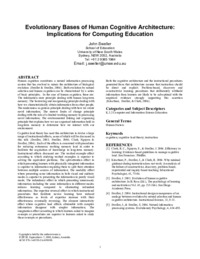Evolutionary bases of human cognitive architectureimplications for computing education
John Sweller
Publikationsdatum:
Zu finden in: ICER 2008 (Seite 1 bis 2), 2008
|
 |
 Diese Seite wurde seit 2 Jahren inhaltlich nicht mehr aktualisiert.
Unter Umständen ist sie nicht mehr aktuell.
Diese Seite wurde seit 2 Jahren inhaltlich nicht mehr aktualisiert.
Unter Umständen ist sie nicht mehr aktuell.
 Zusammenfassungen
Zusammenfassungen
Human cognition constitutes a natural information processing system that has evolved to mimic the architecture of biological evolution (Sweller & Sweller, 2006). Both evolution by natural selection and human cognition can be characterised by a series of basic principles. In the case of human cognition, these are: The information store principle dealing with human long-term memory; The borrowing and reorganising principle dealing with how we characteristically obtain information from other people; The randomness as genesis principle dealing with how we create novel information; The narrow limits of change principle dealing with the role of a limited working memory in processing novel information; The environmental linking and organising principle that explains how we use organised information held in long-term memory to determine how we interact with our environment.
Cognitive load theory has used this architecture to devise a large range of instructional effects, some of which will be discussed in this talk {Sweller, 2003; Sweller, 2004; Clark, Nguyen & Sweller, 2006}. Each of the effects is concerned with procedures for reducing extraneous working memory load in order to facilitate the acquisition of knowledge in long-term memory. Instructional effects discussed are: The worked example effect according to which studying worked examples is superior to solving the equivalent problems; The split-attention effect in which presenting learners with physically integrated information is superior to information requiring them to split their attention between multiple sources of information; The modality effect where presenting some information in both visual and auditory modes is superior to presenting the information in purely visual mode; The redundancy effect in which presenting unnecessary information including the same information in different modes reduces learning compared to eliminating redundant information; The expertise reversal effect in which instructional procedures that facilitate novice learning have reduced effectiveness as levels of expertise increase with their effectiveness eventually reversing; The element interactivity effect where cognitive load effects obtainable with complex information disappear with simpler information; The imagination effect according to which learners asked to imagine concepts or procedures are superior to learners asked to study those concepts or procedures.
Both the cognitive architecture and the instructional procedures generated from that architecture assume that instruction should be direct and explicit. Problem-based, discovery and constructivist learning procedures that deliberately withhold information from learners are likely to be sub-optimal with the empirical evidence strongly supporting this assertion {Kirschner, Sweller, & Clark, 2006}.
 Dieses Konferenz-Paper erwähnt ...
Dieses Konferenz-Paper erwähnt ...
 Begriffe KB IB clear | cognitive load theory (CLT) |
 Anderswo finden
Anderswo finden
 Volltext dieses Dokuments
Volltext dieses Dokuments
 |  Evolutionary bases of human cognitive architecture: Fulltext at the ACM Digital Library ( Evolutionary bases of human cognitive architecture: Fulltext at the ACM Digital Library ( : :  , 140 kByte; , 140 kByte;  : :  Link unterbrochen? Letzte Überprüfung: 2020-11-28 Letzte erfolgreiche Überprüfung: 2020-06-28) Link unterbrochen? Letzte Überprüfung: 2020-11-28 Letzte erfolgreiche Überprüfung: 2020-06-28) |
 Anderswo suchen
Anderswo suchen 
 Beat und dieses Konferenz-Paper
Beat und dieses Konferenz-Paper
Beat hat Dieses Konferenz-Paper während seiner Zeit am Institut für Medien und Schule (IMS) ins Biblionetz aufgenommen. Beat besitzt kein physisches, aber ein digitales Exemplar. Eine digitale Version ist auf dem Internet verfügbar (s.o.). Aufgrund der wenigen Einträge im Biblionetz scheint er es nicht wirklich gelesen zu haben. Es gibt bisher auch nur wenige Objekte im Biblionetz, die dieses Werk zitieren.










 Biblionetz-History
Biblionetz-History